GLBenchmark 2.5 Performance on Modern Android Smartphones & Tablets
by Anand Lal Shimpi & Brian Klug on July 31, 2012 10:00 AM EST- Posted in
- Smartphones
- GLBenchmark
- Mobile
- Tablets
- SoCs
Smartphones
There's a bit more variety in our smartphone GLBenchmark 2.5 results. Here we have two Samsung SoCs paired with the ARM Mali-400 MP4 GPU: the original dual-core Exynos 4210 as well as the Exynos 4 Quad (4412) from the international Galaxy S 3. Tegra 3 makes an appearance, as does TI's OMAP 4460. The latter shows up in two configurations, one with the SGX 540 running at full 384MHz clocks in the Huawei Ascend P1 and another with the SGX 540 running at 307MHz in the Galaxy Nexus (CPU clocks are 20% lower as well in the GN). Finally we have Qualcomm's dual-core Snapdragon S4 with its Adreno 225 GPU in the HTC One X and the US Galaxy S 3.
The Mali-400/MP4 continues to be the fill rate king, outpacing NVIDIA's Tegra 3 by over 50%. The advantage doesn't extend however to the triangle tests, expressing a key weakness in the Mali-400/MP4 architecture: significantly ratchet up polygon counts and performance falls flat. Remember that Mali-400 isn't a unified shader architecture, and explicitly features more pixel shader hardware than vertex shader hardware. Qualcomm inches ahead in the vertex and fragment lit triangle throughput tests, although NVIDIA remains quite competitive. Both the Mali-400 and SGX 540 don't do well here.
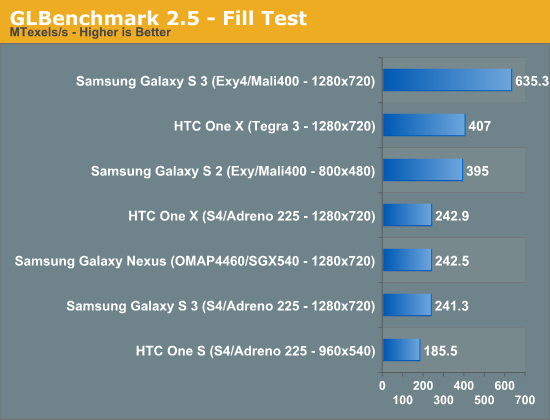
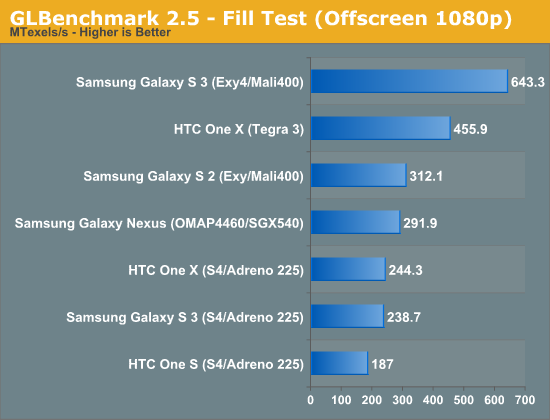
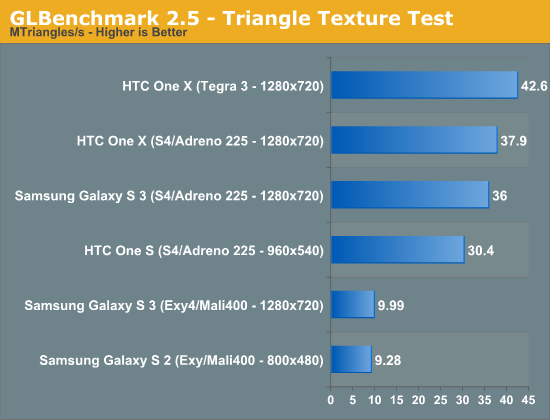
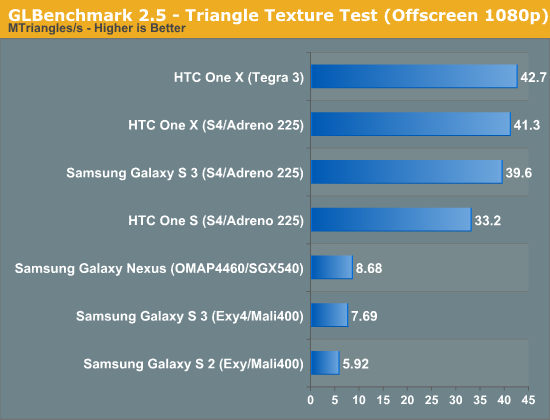
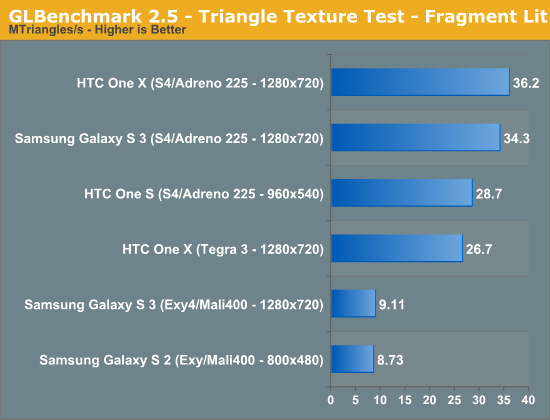
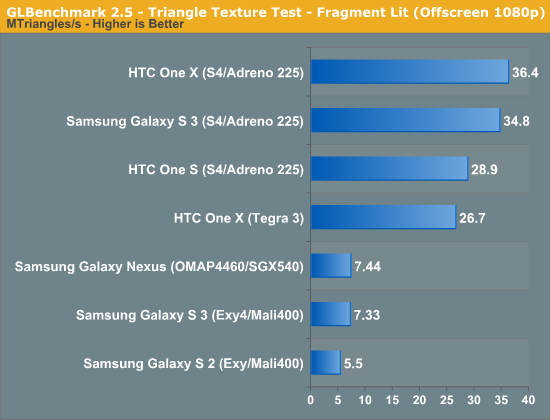
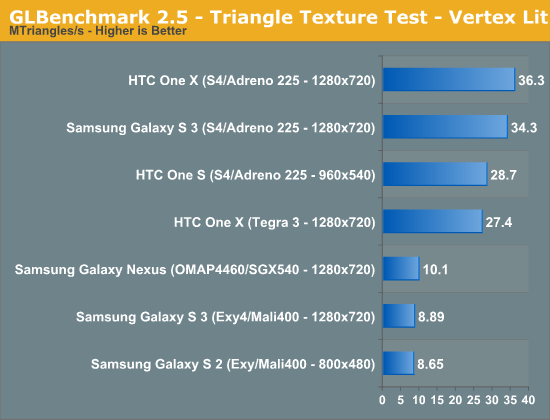

Egypt HD doesn't look quite as bad in the smartphone results, but that's mostly because we have some resolutions at 960 x 540 or below. Even then, none of these devices can break 30 fps. Remove vsync and crank up the resolution to 1080p and we hit the same ~13 fps cap as we did on the tablets.


The classic results once again show us that for lighter workloads, all of the modern GPUs (Mali 400, Adreno 225, Tegra 3) are sufficient. At lower polygon counts, even the latest Mali 400 can hit nearly 60 fps at 1080p.
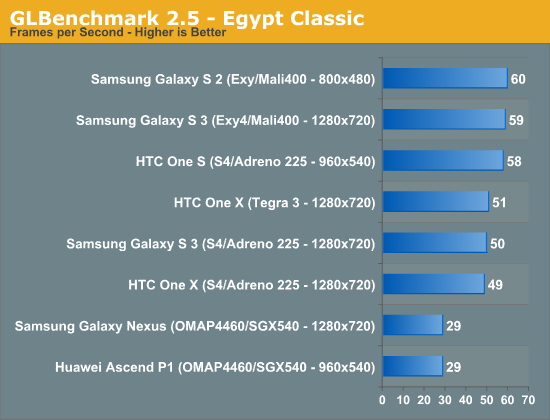
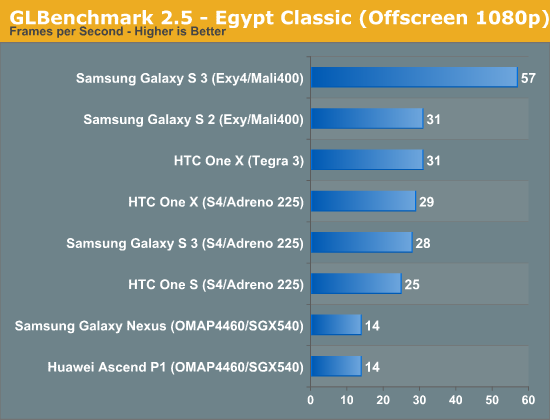










47 Comments
View All Comments
ewood - Tuesday, July 31, 2012 - link
read the article before you ridicule someone's post.aruisdante - Tuesday, July 31, 2012 - link
This is because they Egypt test favors Vertex shading power, and Mali400 is intentionally lacking in that department. If you were to built a test that was pixel shader heavy, the results would be more balanced. You saw this same kind of thing happen in the GeForce 7, Radion X1900 era, when it was nVidia that decided it was better to have more Pixel power than Vertex power. The SGX doesn't haven't to worry about that since it's USA.jeremyshaw - Tuesday, July 31, 2012 - link
I think it was ATi that made the first jump, with the X1950. 48..... 48!! Pixel shaders vs only 16 vertex.Before that, for both ATi and nVidia, it was pretty much always 1:1 pixel:vertex at the top end.
Death666Angel - Tuesday, July 31, 2012 - link
In the game benchmark I see the Quad Exynos being equal to or better than Tegra3. That the Dual Exynos holds its own quite well, considering it launched over half a year earlier. :)At this point though, I wouldn't buy a full price kit with either processor.
Stormkroe - Tuesday, July 31, 2012 - link
Looks like offscreen Mali400 scores are STILL broken in the game tests. Scores 13 fps in 720p and 1080p. Not as bad as going the score going dramatically UP when jumping from 800x400 to 720p like in glbenchmark 2.1, but still... Why hasn't this been addressed?aruisdante - Tuesday, July 31, 2012 - link
Because increasing the resolution increases the load on Pixel shaders more than Vertex shaders, and Mali400 is hamstrung by its Vertex power in this test, so it has the Pixel shading power to spare. It doesn't surprise me that the framerate doesn't change with resolution in this case.Stormkroe - Tuesday, July 31, 2012 - link
But they DO change, in gl2.1 they actually go UP by a lot. That's going from 800x480 to 720p (2.4 times the pixels). Even more proof is that the same SoC in the galaxy note, which has a native resolution very close to 720p used in these off screen tests, shows appropriately scaling performance. It's only when rendering offscreen that Mali400 is able to beat the competition. In glbenchmark2.5 they don't go up, but stay the same, even though there is now a 5.9 factor difference in pixel count. The galaxy note numbers prove that it's not a vertex shader issue. Let's even say that the Mali is so vertex bound (remember it has to be at LEAST 6x deficiency vs the rest of the gpu based on these scores), the fps should still have went down because of the increased demands on the rest of the SoC.I still say offscreen Mali400- broken.
metafor - Tuesday, July 31, 2012 - link
Egypt 2.1 didn't have complex shaders like 2.5. If only one thing in Mali is bottlenecked (like the vertex shader) then nothing else will change. 2.1 simply didn't provide enough complex shaders to bottleneck the vertex shaders, especially at lower resolutions.Stormkroe - Tuesday, July 31, 2012 - link
I'm resisting the urge to go all caps fury here. It's not a bottleneck issue. The offscreen score @720p is HIGHER than the native score at 480p (scores are well below vsync so it can't be that). And offscreen scores @720p are almost double what near-720p resolutions show when they are native.Reduced completely: why does simply going offscreen nearly Double The SCOREOHGOSH I DIDN'T MAKE IT!??!
Rurou - Tuesday, July 31, 2012 - link
I'm also resisting to go all caps, but what are you talking about?Egypt HD:
Galaxy S2 (800x480): 9.1
Galaxy S3 (Mali, 1280x720): 13
Egypt HD offscreen (1080p):
Galaxy S2: 8.8
Galaxy S3 (Mali): 13
Egypt Classic:
Galaxy S2: 60
Galaxy S3: 59
Egypt Classic offscreen (1080p):
Galaxy S2: 31
Galaxy S3: 57
What is the point that you're trying to make? I don't understand. Have you downloaded GLBenchmark 2.5?
All hardware have lower fps on offscreen test, with the exception of Galaxy S3, which suggest that Galaxy S3 was severely vertex limited.. heck, even Galaxy S2 is severely vertex limited because that kind of difference is usually within the margin of error.
Where is this double thing that you mentioned? or are you seeing double? Or are you talking something that wasn't presented in the article? If that is the case, then in what way it affects the result from the article?